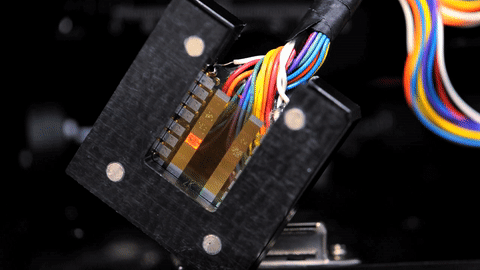Perovskite LED promises higher color quality and ease of manufacture, so it is oven considered a solution to breakthrough LED applications. However, it has been known to fail when subjected to the kind of electrical current typically needed for practical uses. A research team from Princeton University has demonstrated improvement of perovskite LED in stability and performance by better managing the thermal dissipation.

(Photo by Sameer A. Khan/Fotobuddy; image source: Princeton)
The research, published in Advanced Materials, is titled “Thermal Management Enables Bright and Stable Perovskite Light‐Emitting Diodes.” Researchers identified several techniques that reduce the accumulation of heat within the material, which extended its lifetime tenfold. When the researchers prevented the device from overheating, they were able to pump enough current into it to produce light hundreds of times more intense than a typical cell phone display. The intensity, measured in watts per square meter, reflects the real amount of light coming from a device, uninfluenced by human eyes or the color of the light. Previously, such a level of current would have caused the LED to fail.
The advance establishes a new brightness record and expands the limits of what's possible for the material by enhancing the well-established properties of perovskite LEDs and allowing those characteristics to be practically harnessed.
"It's the first time we've shown that heat appears to be the major bottleneck for these materials operating at high currents," said Barry Rand, the research lead. "This means the material could be used for bright lights and displays, which was never thought to be possible."
To contain the accumulation of Joule heat within the device, the researchers engineered the material's composition in the device to make it more electrically conductive and, therefore, generate less heat during operation. They made the devices narrower than usual and added heat sinks, or components that conduct heat away from sensitive electrical components, which helped to disperse the heat.
Once these key elements were in place, they employed a tactic to continually "pulse" the device, or quickly turn it on and off, so fast that a human eye could not see the flicker, but enough time for the device to recover and cool. By reducing the amount of time the device was actually on, the researchers achieved efficiency improvements, and were able to operate the device longer than had ever been reported. Rand describes the work as a "how-to" guide for operating perovskite LEDs at the high power densities required for lighting and bright displays.
(Original content by Molly A. Seltzer, Princeton University; edited by LEDinside)












